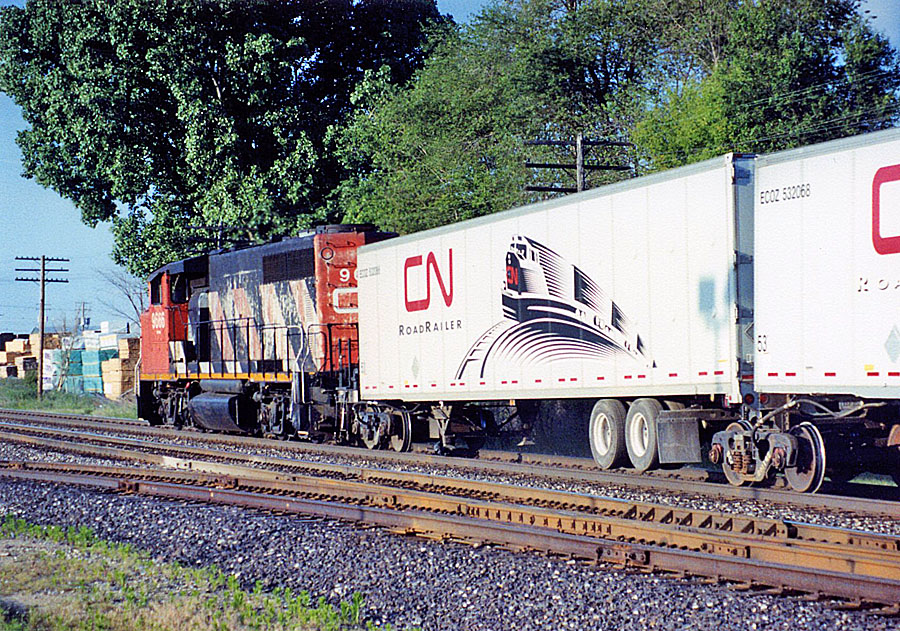History: In railroad terminology a Roadrailer or RoadRailer is a highway trailer, or semi-trailer, that is specially equipped for use in railroad intermodal service. The advantage of using roadrailers is their ability to be used directly behind other freight (or even passenger) equipment without the use of trailer flatcars.
Roadrailers first appeared on American railroads in the 1950s. The trailers were built with integrated railroad wheelsets that could be lowered into position when the trailer was pulled behind a train. More modern roadrailers do not include integrated railroad wheels, but ride on regular trucks that do double-duty, serving as articulation points between multiple trailers in a train. Each regular truck is equipped with ONE fifth wheel at one end and a connector plate at the other end. The connector plate slides into a female receptacle on the rear of the trailer in front and is secured with a steel pin. At the head of a Road Railer train there is an adaptor truck equipped with one fifth wheel and one regular AAR Type "E" or Type "F" automatic coupler. Each semi-trailer has one king pin at each end. Because the truck (bogie) is significantly lighter than a rail flatcar or well-car, roadrailer freight trains are much lighter and therefore are more energy efficient than traditional intermodal trains.
Triple Crown still uses them and their photo is used in this article. The "TCSZ" on the trailer is the AAR reporting mark for Triple Crown Service. The trailer number beginning with 464 indicates that the trailer was built approximately 1999-2002, and weighs only 1,000 lb (454 kg) more than a regular highway-only trailer.
From Wikipedia
Roadrailers first appeared on American railroads in the 1950s. The trailers were built with integrated railroad wheelsets that could be lowered into position when the trailer was pulled behind a train. More modern roadrailers do not include integrated railroad wheels, but ride on regular trucks that do double-duty, serving as articulation points between multiple trailers in a train. Each regular truck is equipped with ONE fifth wheel at one end and a connector plate at the other end. The connector plate slides into a female receptacle on the rear of the trailer in front and is secured with a steel pin. At the head of a Road Railer train there is an adaptor truck equipped with one fifth wheel and one regular AAR Type "E" or Type "F" automatic coupler. Each semi-trailer has one king pin at each end. Because the truck (bogie) is significantly lighter than a rail flatcar or well-car, roadrailer freight trains are much lighter and therefore are more energy efficient than traditional intermodal trains.
Triple Crown still uses them and their photo is used in this article. The "TCSZ" on the trailer is the AAR reporting mark for Triple Crown Service. The trailer number beginning with 464 indicates that the trailer was built approximately 1999-2002, and weighs only 1,000 lb (454 kg) more than a regular highway-only trailer.
From Wikipedia
Railroad/Company: The Budd Company was a 20th-century metal fabricator, a major supplier of body components to the automobile industry and a manufacturer of stainless steel passenger rail cars, airframes, missile and space vehicles, various defense products.
Budd was founded in 1912 in Philadelphia by Edward G. Budd, whose fame came from his development of the first all-steel automobile bodies in 1913 and, in the 1930s, his company's invention of the "shotweld" technique for joining pieces of stainless steel without damaging its anti-corrosion properties.
Budd Company became part of Budd Thyssen in 1978 and in 1999 a part of ThyssenKrupp Budd. Body and chassis operations were sold to Martinrea International in 2006. No longer an operating company, Budd filed for bankruptcy in 2014. It currently exists to provide benefits to its retirees.
Read more on Wikipedia.
Budd was founded in 1912 in Philadelphia by Edward G. Budd, whose fame came from his development of the first all-steel automobile bodies in 1913 and, in the 1930s, his company's invention of the "shotweld" technique for joining pieces of stainless steel without damaging its anti-corrosion properties.
Budd Company became part of Budd Thyssen in 1978 and in 1999 a part of ThyssenKrupp Budd. Body and chassis operations were sold to Martinrea International in 2006. No longer an operating company, Budd filed for bankruptcy in 2014. It currently exists to provide benefits to its retirees.
Read more on Wikipedia.
Item Links: We found: 1 different collections associated with Intermodal - Rolling Stock (Freight) - Roadrailer
- Collection N Scale Model Trains: 81 different items.
Item created by: gdm on 2018-01-23 10:48:40. Last edited by gdm on 2018-10-19 18:03:27
If you see errors or missing data in this entry, please feel free to log in and edit it. Anyone with a Gmail account can log in instantly.
If you see errors or missing data in this entry, please feel free to log in and edit it. Anyone with a Gmail account can log in instantly.








